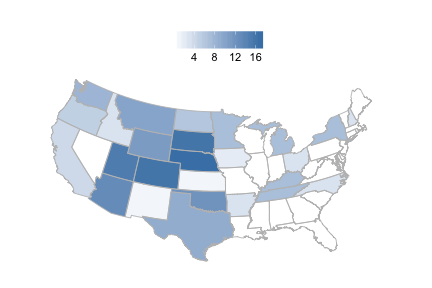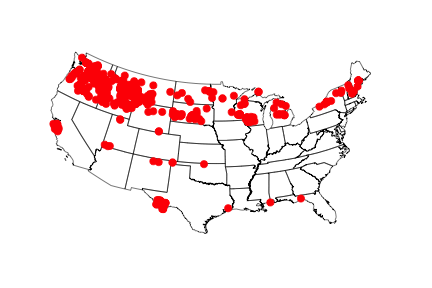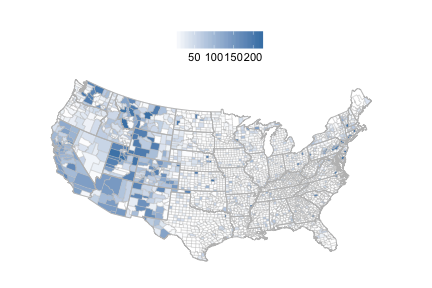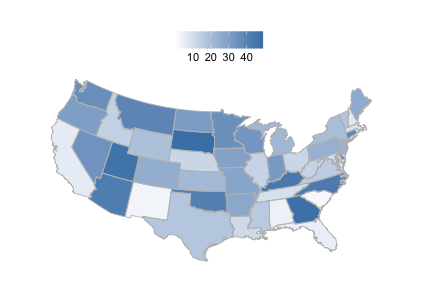rbison tutorial
for v0.4.8
rbison is an R package to search and retrieve data from the USGS BISON service. rbison wraps R code around the BISON API to allow you to talk to the BISON database from R.
BISON has occurrence data for the US only.
BISON is a node of the Global Biodiversity Information Facility (GBIF) - i.e., you can get data that’s available in BISON via GBIF instead if you want.
Info
See http://bison.usgs.ornl.gov/doc/api.jsp for API docs for the BISON API.
## Installation
```r
install.packages("rbison")
```
Or development version from GitHub
```r
install.packages("devtools")
devtools::install_github("ropensci/rbison")
```
```r
library("rbison")
```
## Usage
Notice that the function `bisonmap` automagically selects the map extent to plot for you, being one of the contiguous lower 48 states, or the lower 48 plus AK and HI, or a global map. If some or all points outside the US, a global map is drawn, and throws a warning. You may want to make sure the occurrence lat/long coordinates are correct.
## Get data
```r
out <- bison(species = "Helianthus annuus", count = 10)
```
Inspect summary
```r
out$summary
#> total observation fossil specimen unknown living centroid
#> 1 6090 592 102 3946 1448 2 1
```
Map occurrences
```r
head(out$counties)
#> record_id total county_name state
#> 1 20041 3 Dickinson County Kansas
#> 2 54103 1 Wetzel County West Virginia
#> 3 40149 1 Washita County Oklahoma
#> 4 54105 1 Wirt County West Virginia
#> 5 29025 1 Caldwell County Missouri
#> 6 40143 2 Tulsa County Oklahoma
```
## All points within the US (including AK and HI)
Get data
```r
out <- bison(species="Bison bison", count=600)
```
Inspect summary
```r
out$summary
#> total observation fossil specimen unknown centroid
#> 1 1217 252 162 796 7 1
```
Map occurrences
```r
bisonmap(out, tomap="state")
```

## All points within the contiguous 48 states
Get data
```r
out <- bison(species="Aquila chrysaetos", count=600)
```
Inspect summary
```r
out$summary
#> total observation fossil specimen unknown centroid
#> 1 84111 82185 102 1811 13 1
```
Map occurrences
```r
bisonmap(out, tomap="points")
```

## Plot county or state
With any data returned from a `bison` call, you can choose to plot county or state level data
Counties - using last data call for Aquila
```r
bisonmap(out, tomap="county")
```

States - using last data call for Aquila
```r
bisonmap(out, tomap="state")
```

## Constrain search with county IDs or bounding boxes
### Constrain search to a certain county.
Check out [this site](http://www.epa.gov/enviro/html/codes/state.html) to get state and county fips codes. Fips codes are like so: First two digits are the state code - last three are the county code. For example the *06* in 06037 is the state of California, and the *037* is the Los Angeles county.
```r
out <- bison(species="Helianthus annuus", countyFips = "06037")
```
Inspect summary
```r
out$summary
#> total observation fossil specimen unknown living centroid
#> 1 6090 592 102 3946 1448 2 1
```
By default, the query only returned 10 records
```r
head(out$points)
#> name decimalLongitude decimalLatitude occurrenceID
#> 1 Helianthus annuus -97.05048 36.15451 924819078
#> 2 Helianthus annuus -119.65502 36.76101 1022149513
#> 3 Helianthus annuus -97.83139 27.40750 91592123
#> 4 Helianthus annuus -105.21948 43.52802 891126339
#> 5 Helianthus annuus -103.42134 43.60460 891030944
#> 6 Helianthus annuus -100.87222 37.97167 91592528
#> provider basis
#> 1 Emporia State University Specimen
#> 2 Consortium of California Herbaria Specimen
#> 3 US National Plant Germplasm System Unknown
#> 4 iNaturalist.org Observation
#> 5 iNaturalist.org Observation
#> 6 US National Plant Germplasm System Unknown
#> common_name geo
#> 1 common sunflower, annual sunflower, wild sunflower, sunflower Yes
#> 2 common sunflower, annual sunflower, wild sunflower, sunflower Yes
#> 3 common sunflower, annual sunflower, wild sunflower, sunflower Yes
#> 4 common sunflower, annual sunflower, wild sunflower, sunflower Yes
#> 5 common sunflower, annual sunflower, wild sunflower, sunflower Yes
#> 6 common sunflower, annual sunflower, wild sunflower, sunflower Yes
```
Or specify county by its actual name - probably much easier.
```r
out <- bison(species="Helianthus annuus", county = "Los Angeles")
```
Inspect summary
```r
out$summary
#> total observation fossil specimen unknown centroid
#> 1 164 28 3 126 7 1
```
By default, the query only returned 10 records
```r
head(out$points)
#> name decimalLongitude decimalLatitude occurrenceID
#> 1 Helianthus annuus -118.1358 34.69806 40886950
#> 2 Helianthus annuus -118.1358 34.69806 40886951
#> 3 Helianthus annuus -118.1358 34.69806 40886952
#> 4 Helianthus annuus -118.1358 34.69806 40886953
#> 5 Helianthus annuus -118.8517 34.79611 40886954
#> 6 Helianthus annuus -118.8517 34.79611 40886955
#> provider basis
#> 1 US National Plant Germplasm System Unknown
#> 2 US National Plant Germplasm System Unknown
#> 3 US National Plant Germplasm System Unknown
#> 4 US National Plant Germplasm System Unknown
#> 5 US National Plant Germplasm System Unknown
#> 6 US National Plant Germplasm System Unknown
#> common_name geo
#> 1 common sunflower, annual sunflower, wild sunflower, sunflower Yes
#> 2 common sunflower, annual sunflower, wild sunflower, sunflower Yes
#> 3 common sunflower, annual sunflower, wild sunflower, sunflower Yes
#> 4 common sunflower, annual sunflower, wild sunflower, sunflower Yes
#> 5 common sunflower, annual sunflower, wild sunflower, sunflower Yes
#> 6 common sunflower, annual sunflower, wild sunflower, sunflower Yes
```
`bison` will help you if you spell the name wrong, or use a partial name. The results are not printed below, but you would get a prompt asking you to pick between the two counties that start with *Los*.
```r
bison(species="Helianthus annuus", county = "Los")
```
### Constrain search to a amorphous area.
Check out the Wikipedia page [here](http://en.wikipedia.org/wiki/Well-known_text) for an in depth look at the options, terminology, etc.
```r
out <- bison(species="Helianthus annuus", aoi = "POLYGON((-111.06360117772908 38.84001566645886,-110.80542246679359 39.37707771107983,-110.20117441992392 39.17722368276862,-110.20666758398464 38.90844075244811,-110.63513438085685 38.67724220095734,-111.06360117772908 38.84001566645886))")
```
Inspect summary
```r
out$summary
#> total specimen centroid
#> 1 1 1 1
```
The data
```r
out$points
#> name decimalLongitude decimalLatitude occurrenceID provider
#> 1 Helianthus annuus -110.7211 39.00903 15613677160 BISON
#> basis common_name
#> 1 Specimen common sunflower, annual sunflower, wild sunflower, sunflower
#> geo
#> 1 Yes
```
### Constrain search to a certain aoibbox.
An aoibbox uses the format minx, miny, maxx, maxy.
```r
out <- bison(species="Helianthus annuus", aoibbox = '-120.31,35.81,-110.57,40.21')
```
Inspect summary
```r
out$summary
#> total observation fossil specimen unknown centroid
#> 1 331 39 8 207 77 1
```
The data, by default, the query only returned 10 records
```r
head(out$points)
#> name decimalLongitude decimalLatitude occurrenceID
#> 1 Helianthus annuus -119.6550 36.76101 1022149513
#> 2 Helianthus annuus -111.2217 38.11111 91592125
#> 3 Helianthus annuus -110.6722 35.92778 40887980
#> 4 Helianthus annuus -119.3464 36.20778 40892466
#> 5 Helianthus annuus -119.7819 36.30083 40886962
#> 6 Helianthus annuus -119.4192 36.35111 40892467
#> provider basis
#> 1 Consortium of California Herbaria Specimen
#> 2 US National Plant Germplasm System Unknown
#> 3 US National Plant Germplasm System Unknown
#> 4 US National Plant Germplasm System Unknown
#> 5 US National Plant Germplasm System Unknown
#> 6 US National Plant Germplasm System Unknown
#> common_name geo
#> 1 common sunflower, annual sunflower, wild sunflower, sunflower Yes
#> 2 common sunflower, annual sunflower, wild sunflower, sunflower Yes
#> 3 common sunflower, annual sunflower, wild sunflower, sunflower Yes
#> 4 common sunflower, annual sunflower, wild sunflower, sunflower Yes
#> 5 common sunflower, annual sunflower, wild sunflower, sunflower Yes
#> 6 common sunflower, annual sunflower, wild sunflower, sunflower Yes
```
## Citing
To cite `rbison` in publications use:
> Scott Chamberlain (2015). rbison: R interface to the USGS BISON API. R package version 0.4.8 http://CRAN.R-project.org/package=rbison
## License and bugs
* License: [MIT](http://opensource.org/licenses/MIT)
* Report bugs at [our Github repo for rbison](https://github.com/ropensci/rbison/issues?state=open)
[Back to top](#top)
